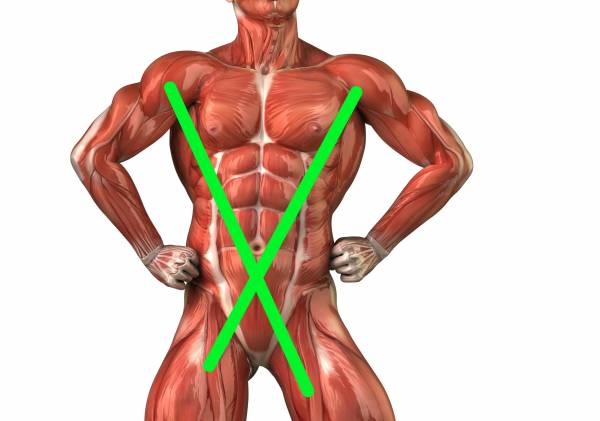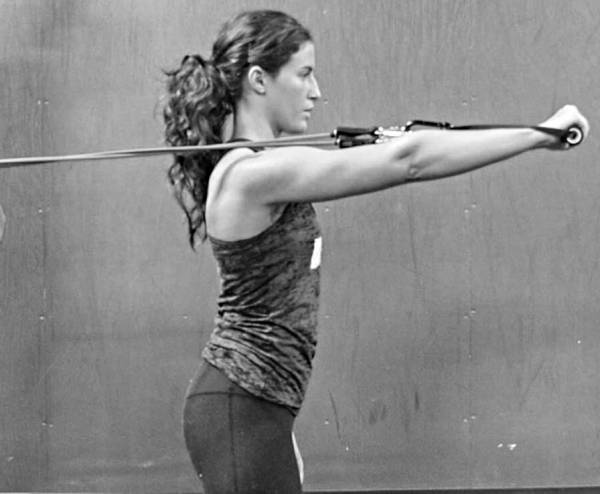Power lives in the transverse plane. If you want to unleash that power you need to control it first. Golfing expert Lance Gill says, “If you don’t own the transverse plane, you are playing for second place.”
That’s a pretty straightforward way to say if you want to be the champion, then you need to harness rotation. The tall kneeling press is a great place to start. You only need a resistance band, an anchor point, and your obliques. It’s simple and effective, but surprisingly not as easy as you think.
Rotation is controlled by the obliques and spinal stabilizers, which are responsible for transverse plane patterning.
Force Transfer and Rotation
Force transfer is the name of the game in performance and durability – from ground reaction forces on your foot strike up the movement chain to the central axis (core) and crossing over to the opposite side of the body. Rotation of the torso is controlled by the external obliques, internal obliques, and multifidi/rotatores (spinal stabilizers). Understanding the role of the obliques is essential to hacking into transverse plane patterning.
Some basic facts:
- The external oblique is a contralateral (opposite side) rotator.
- The internal oblique is an ipsilateral (same side) rotator.
- Right thoracic spine rotation uses the left external oblique and the right internal oblique.
- Left thoracic spine rotation uses the right external oblique and the left internal oblique.
The obliques are part of the anterior oblique subsystem of movement (AOS). The AOS is a system of force transmission on the front of the body and is comprised of the abdominal obliques and hip adductors. You can functionally extend that line further up to include the pectorals.
Said another way: imagine drawing a line from the left shoulder to the inside of the right thigh and one from right shoulder to left hip adductors. These lines crisscross in the midline (the abdominal core). This is all your AOS.

The AOS is a system of force transmission on the front of the body. It is comprised of the abdominal obliques and hip adductors.
So, if your training engages the AOS, but your obliques don’t function efficiently (which is often the case), then your body compensates by using more of the adductors. This leads to potential injury in the hip, groin, and knee. We want to minimize the role of the adductors when training this system until we can control the obliques. Hence, the tall kneeling power press.
Tall Kneeling Power Press
Note: This exercise is also an assessment for how well the obliques function.
- Anchor a variable resistance band at roughly shoulder height.
- Face the anchor point. Hold handle and step backward to get tension in the band.
- Turn around and face away from the anchor point.
- Go down to tall kneeling. Position both knees a comfortable distance from each other.
- Dorsiflex (bend) the ankles. This prevents you from curling your toes and engaging the calf muscles as a compensation or the stabilization you need in the core. Overusing the gastrocnemius muscle is a common cheat for core strength.
- Imagine a straight line drawn on the side of your body through your shoulder, hip, and knee. This will help prevent flexion in the lower back and loss of stabilization. (Note: If this is difficult, you may have a hip mobility restriction and adequate hip extension may not be possible until you get more movement in the hips with mobility work.)
- Do not over grip the band or handle. Gripping too much is a sign of instability in the core. Using a single hand, press the band out in front away from you and hold for four seconds. Do not hold your breath.
- Maintain shoulders in line with the hips while resisting rotation. This is the anti-rotation position.
- Eccentrically control the band back toward the chest.
- Repeat 8-10 times, and then repeat on the opposite side.
Now that you’ve tried the exercise, ask yourself, “Does one side feel weaker and less stable than the other?” If so, that indicates an imbalance in the rotational sling. Why does that matter? It makes the body more susceptible to injury with a transverse (rotational) plane imbalance. You should be able to maintain a four-second static hold for the desired number of repetitions. If you can’t maintain breathing during the entire set then the resistance you’ve chosen is too much.
Considerations
Two more concepts to consider:
- Pressing with the right hand is left thoracic spine rotation and you are using the right external and left internal oblique.
- Pressing with the left hand is right thoracic spine rotation and you are using the left external and right internal oblique.
So imagine this scenario: You tried the exercise and your right arm was weaker. This may be linked to a right shoulder pain or left hip and knee pain. So how do you then reset the pattern for better function? Use my simple RAIL Reset System.
RAIL stands for release, activate, integrate, locomotion. You need to release the muscles that are doing too much work (in this case, the pecs and adductors). Activate and integrate the muscles not doing enough. And then you can load the body with a walking pattern.
- Release: Work on the pec major and minor with a lacrosse ball or roller. Release the opposite side hip adductors with a roller. Repeat this pattern on both sides.
- Activate/Integrate: Use the AOS muscles in a pattern. Perform the tall kneeling press for 8-10 repetitions on both sides.
- Locomotion: Stand up and walk.
Does the weakness you felt before the reset feel different now? It is common to feel immediately stronger and more powerful because you’ve now patterned the muscles to work together.

If one side is weaker than the other, this indicates imbalance in the rotational sling.
Sets and Reps
You can do the tall kneeling press for 1-2 sets of 8-12 repetitions mixed into any workout. Once you’ve mastered it, you can move on to the half kneeling press – with one knee on the ground and opposite foot forward. But more details on that in another article.
The takeaway today is don’t underestimate the power of the transverse plane. Rotation is where #beastmode lives.
More Like This:
- The RAIL System: Shoulder Mobility for the Bench Press
- Find Your Movement Medicine With Dr. Perry Nickelston
- Take Your Strength to the Next Level With Ipsilateral Crawling
- New on Pulse Beat Fit Today
References:
1. Cook, Gray. Movement: Functional Movement Systems: Screening, Assessment, and Corrective Strategies. Aptos, CA: On Target Publications, 2010. Print.
2. John, Dan, and Pavel Tsatsouline. Easy Strength: How to Get a Lot Stronger than Your Competition – and Dominate in Your Sport. New York, NY: Dragon Door Publications, 2011. Print.
3. Tippett, Steven R., and Michael L. Voight. Functional Progressions for Sport Rehabilitation. Champaign, IL: Human Kinetics, 1995. Print.
Photos 1 and 2 courtesy of Shutterstock.






